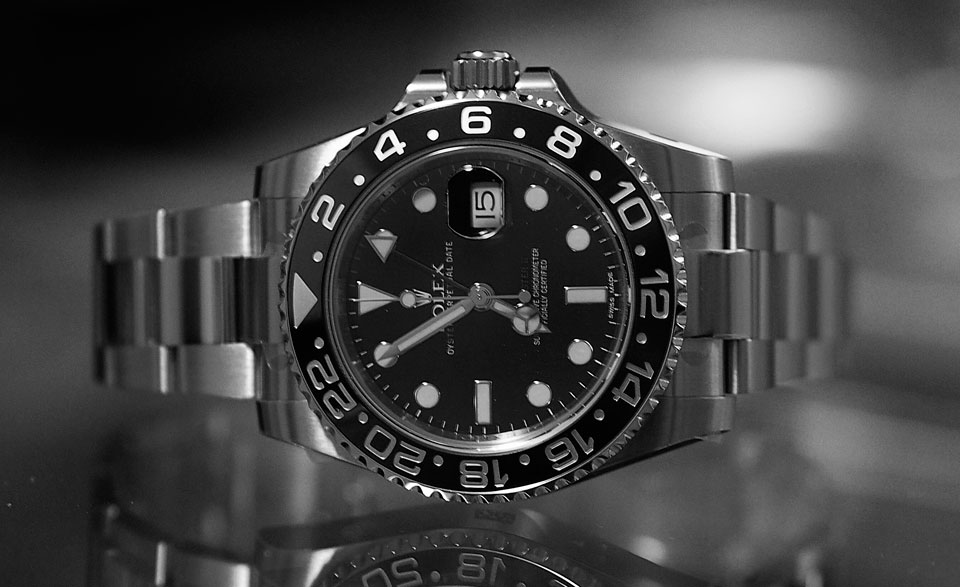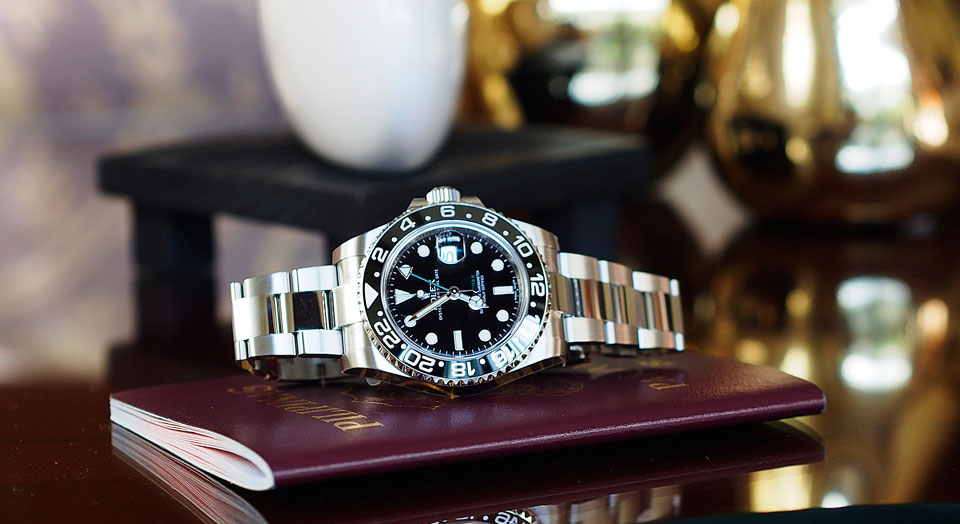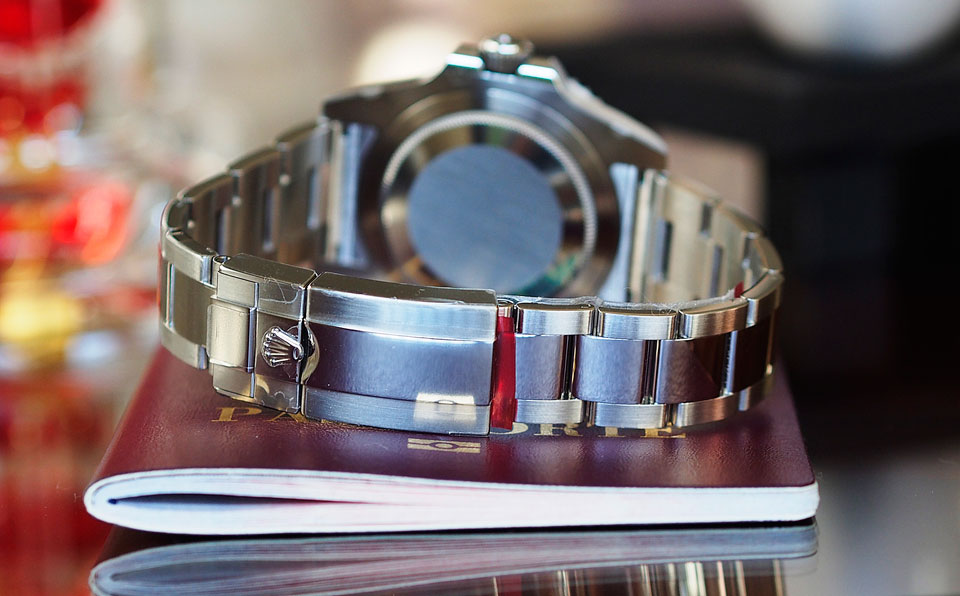An Early Retrospective – Rolex GMT-Master II Lunette Noire Ceramic

The recent release of the bi-colored Cerachrom bezel Rolex GMT-Master II in Basel 2013 made headlines in the horological world. The use of two colors in a monobloc bezel was deemed to be impossible before; hence the 2013 GMT-Master II is the first of its kind. Now rewind the clock a little bit, and you’ll find out that the 2005 GMT-Master II was, in fact, the first Rolex to be outfitted with their patented Cerachrom technology. So it’s only fitting that we take an early retrospective on this fantastic ceramic piece before we go all out and grab its newer bi-colored sibling.
The GMT-Master series appears to be taking the helm in terms of ceramic technology for the “Crown”. The importance of the bezel in the GMT-Master is very much apparent for serious travelers. It was a very smart move for Rolex back then to include a supposedly indestructible bezel to the GMT-Master. Although the 2005 yellow gold anniversary model was the star then, it was the later release of a steel-only version (Ref. 116710 LN) that really won the hearts of Rolex collectors.

The steel-only GMT-Master II was released in 2007, right after the release of the steel/yellow gold two-tone version in 2006 (Ref. 116713 LN). The release of the steel-only black bezel was an instant success back in 2007; not only did it attract more buyers because of its lower price in contrast with the gold Anniversary model and the steel/gold version, it also cemented its role as a collector’s item alongside its popular sibling, the “pepsi” version. At that time, a bi-colored Cerachrom bezel was still impossible, and as such, collectors clamored for the next best thing. Moreover, the steel-only version also paid tribute to the original black bezel GMT-Master ref. 1675 released in 1970 (as we showed you here). This makes the black-bezelled GMT-Master II an even more attractive choice for those who are in the market for a new Rolex GMT.
GMT-Master II History:
A little history lesson will tell us that the GMT-Master has been around for more than 50 years already. But only in 1983 did Rolex begin revamping the original GMT model, and thus created the first GMT-Master II – affectionately known as the “Fat Lady” because of its extra thick case and extra large crown guards (Ref. 16760). In addition to its hefty case, it was also the first one to sport a sapphire crystal, an adjustable 24-hour hand, and a new caliber 3085. It was a steel-only release, again with a bi-color bezel, this time in red/black, a new color combination that was later on nicknamed the “Coke” GMT.
After that, the GMT-Master II underwent several transformations (Ref. 16710), a new movement (caliber 3185), and new indices from tritium dials to Luminova, and all the way to Super Luminova – with the later models being equipped with an improved caliber 3186 that is still being used on today’s GMT. Of course, the history lesson wouldn’t be complete without talking about the bezel, which is the single most identifiable design from the Rolex GMT other than its fourth hand. The bezel back then was made of anodized aluminum and rotated bi-directionally at 120 clicks. It was available in three different color schemes, two bi-colored ones (Pepsi and Coke), and one mono-colored (black – or as Rolex would like to call it, “lunette noire” GMT.) Nearly two decades in production, the 16710 were the last of the non-ceramic GMTs. By 2005, the 50th anniversary model was released with a green dial (Ref. 116718 LN) and only on yellow-gold. This marked a new era of GMT pieces from Rolex.
Improvements or Evolution?
The upgraded GMT-Master II features a handful of improvements from its predecessor. Gone are the Twinlock crowns, replaced now by Rolex’s Triplock crown (borrowed from the newer Submariner models), which should increase its resistance to water. On paper, though, the GMT-Master II is still rated at 100 meters, rather than the standard 300 meters of the Submariner.

The newer GMT-Master also features a so-called Maxi dial, again borrowed from the Submariner. Collectors and enthusiasts gave that nickname because of the larger round marker on the dial and the thicker hour and minute hands. The red 24-hour hand was replaced with a green one instead.

It also features a slightly larger case but only in thickness rather than in case diameter. The bracelet has also been revamped with polished center links, and a clasp that collectors had all been asking for – the “Daytona” clasp or “Easylink” for easier length adjustment (another patented technology from the crown.)

The movement caliber number remains the same (3186), but the addition of a new hairspring must not go unnoticed. This time, taken from the Milgauss, the new caliber will come equipped with Rolex’s own in-house “Parachrom” hairspring. This new alloy enables the piece to be anti-magnetic and more resistant to shocks (here we explained more about the Parachrom hairspring).
Last but not at all least, we have the addition of the new Cerachrom bezel, which I have been rambling about since the start of the article… a revolutionary technology that made the most visible part of the GMT complication near indestructible. The bezel is highly scratch-resistant and unaffected by exposure to sunlight, chlorinated water and seawater. So in essence, the 2007 GMT-Master II is some sort of an amalgamation of all Rolex patented technologies. It captures altogether the beauty of the iconic Submariner, the durability of a Milgauss, the comfort of the Daytona, and of course the complication of the GMT. Simply put, this is a prime example of horological evolution.

The 2007 Rolex GMT-Master II truly does remain one of the best Rolex timepieces to own. The newer black and blue variant is simply either a precursor of things to come, or just Rolex’s way of demonstrating that they finally found a way to fuse two colors together – a revolutionary feat, in ceramic technology terms.
Since the inception of the first Cerachrom GMT, it took Rolex two years to finally listen to its loyal fans and release a ceramic lunette noire GMT. So perhaps it may take another year before we actually see a ceramic Pepsi GMT. And by that time, we would then be celebrating the 60th anniversary of the very first GMT-Master ref 6542 that was released with a bakelite red/blue bezel… Coincidence? You be the judge.
Full specifications and more details can be found over at the Rolex website.




1 response
great reviews